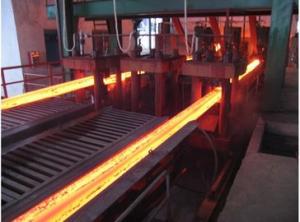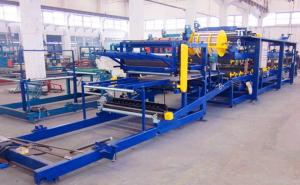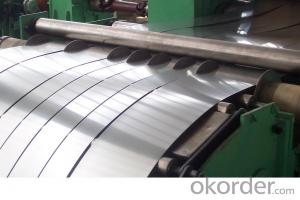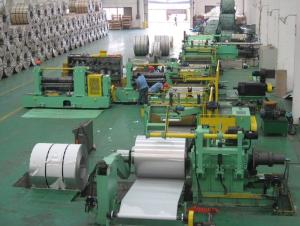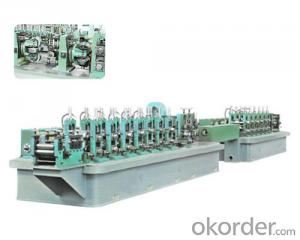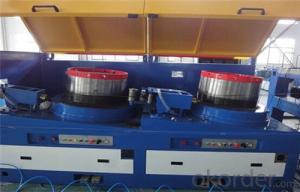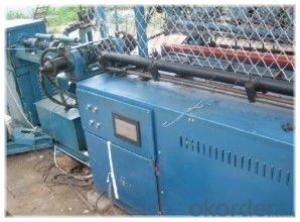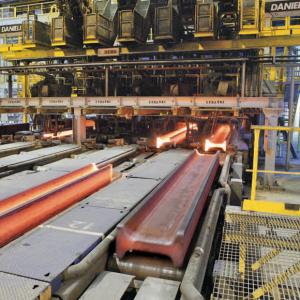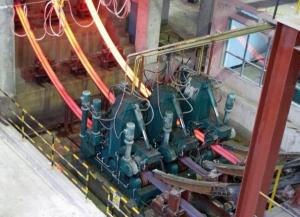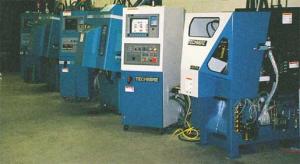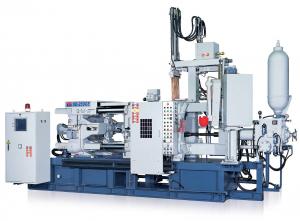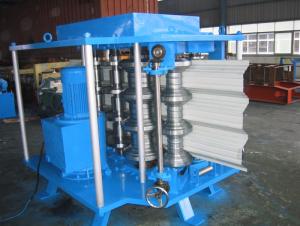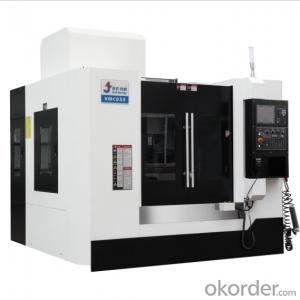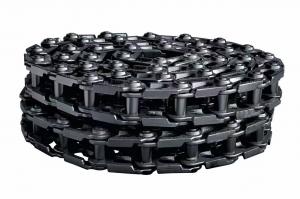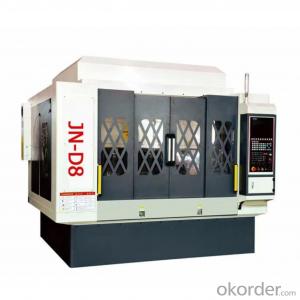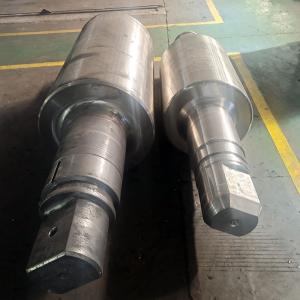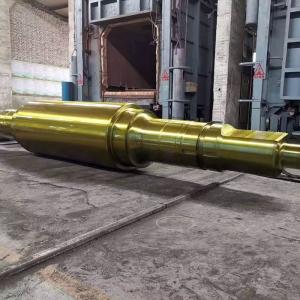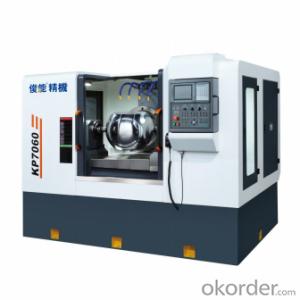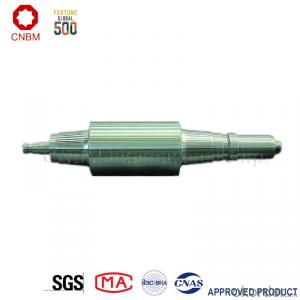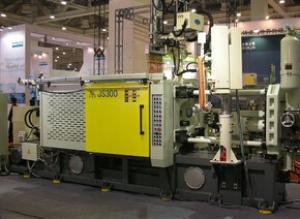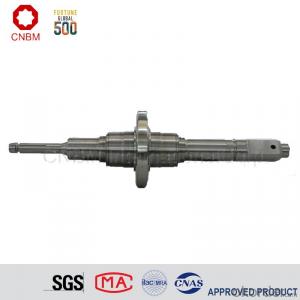Continuous Casting Machine for Square Billet
- Loading Port:
- China Main Port
- Payment Terms:
- TT or LC
- Min Order Qty:
- 1 Set set
- Supply Capability:
- 20 Sets Per Year set/month
OKorder Service Pledge
Quality Product, Order Online Tracking, Timely Delivery
OKorder Financial Service
Credit Rating, Credit Services, Credit Purchasing
You Might Also Like
Technology process:
1.Heat the EVA film
2.Cover the heated EVA film on the mould(can be made from wood or aluminum)
3.Spray a coating in a certain baume degree
4.Put on the empty blask
5.Sand-up the flask and vibrate to compaction
Packaging & Delivery
Packaging Details:containers
Delivery Detail:Complete one set of equipment needs for three months
- Q:How is the pattern attached to the mold in metal casting machinery?
- In metal casting machinery, the pattern is typically attached to the mold through a variety of methods depending on the specific casting process. One common method is using adhesive materials such as glue or wax to secure the pattern onto the mold cavity. This ensures that the pattern remains in place during the casting process and prevents any movement or shifting that may result in a defective final product. In some cases, a combination of mechanical and adhesive methods is used. Mechanical fasteners such as screws or pins may be employed to hold the pattern in place while the adhesive material sets and cures. This provides additional reinforcement and stability to the pattern-mold assembly. Additionally, in certain casting processes like investment casting, the pattern may be encased in a ceramic shell or mold material. The ceramic shell acts as both a support structure and a mold for the metal to be poured into. The pattern is typically coated with a refractory material before being immersed in the ceramic slurry. Once the ceramic shell is hardened, the pattern is removed either by melting it out or by using other methods such as vibration or steam. Overall, the attachment of the pattern to the mold in metal casting machinery is crucial for ensuring the accuracy and quality of the casted product. The chosen attachment method must be strong enough to withstand the forces and temperatures involved in the casting process, while also allowing for easy removal of the pattern once the mold is ready for casting.
- Q:How does metal casting machinery handle the packaging and shipping of castings?
- Metal casting machinery does not handle the packaging and shipping of castings directly. Once the castings are manufactured using the metal casting machinery, they are typically removed from the molds and inspected for quality control. From there, the castings are sent to a separate packaging and shipping department or company for further processing. In the packaging stage, the castings are carefully inspected again to ensure they meet the required standards and specifications. They are then properly cleaned, deburred, and finished if necessary. This is done to remove any excess materials or imperfections, ensuring that the castings are ready for shipping. After the castings have been cleaned and finished, they are carefully packaged to protect them during transportation. This packaging process may involve using specific materials such as foam, bubble wrap, or wooden crates to prevent any damage or breakage. Additionally, the packaging is designed to secure the castings in place and prevent any movement that could potentially cause damage. Once the castings are properly packaged, they are labeled and documented with important information such as their weight, dimensions, and destination. This helps ensure that the correct castings are shipped to the right location. The packaging and shipping department also arranges the logistics of transportation, selecting the most suitable shipping method and carrier based on factors such as cost, distance, and urgency. Overall, metal casting machinery plays a crucial role in the manufacturing process of castings, but it is the responsibility of the packaging and shipping department or company to handle the final stages of preparing the castings for shipment. Their expertise in packaging techniques and knowledge of shipping logistics ensures that the castings reach their destination safely and in optimal condition.
- Q:Can metal casting machinery handle the production of large-scale castings?
- Yes, metal casting machinery can handle the production of large-scale castings. Metal casting machinery is designed to handle a wide range of casting sizes, from small components to large and complex structures. The size and capacity of the machinery can vary depending on the specific casting requirements, but there are machines available that can accommodate the production of large-scale castings. These machines are typically equipped with features such as larger melting capacities, larger molds, and stronger mechanisms to handle the weight and size of the castings. They can handle a variety of metals, including steel, iron, aluminum, and more, which are commonly used in large-scale casting applications. Moreover, advancements in technology and manufacturing processes have further improved the capabilities of metal casting machinery. Computer-controlled systems and automation have enhanced the precision and efficiency of casting processes, allowing for the production of large-scale castings with greater accuracy and consistency. However, it is important to note that the production of large-scale castings requires careful planning and consideration. Factors such as mold design, material properties, and cooling methods need to be taken into account to ensure successful casting production. Additionally, the size and weight of the castings may require specialized equipment for handling and transportation. In summary, metal casting machinery is capable of handling the production of large-scale castings. With the right equipment, expertise, and planning, manufacturers can efficiently produce castings of various sizes to meet the demands of different industries.
- Q:How is the mold created in metal casting machinery?
- The mold is created in metal casting machinery through a process called patternmaking. A pattern, typically made of wood or metal, is shaped to resemble the desired final product. The pattern is then placed in a specially prepared sand mixture, which is packed tightly around it to create a mold cavity. Once the pattern is removed, molten metal is poured into the mold cavity, taking the shape of the pattern. After the metal cools and solidifies, the mold is broken to reveal the newly cast metal object.
- Q:How does metal casting machinery handle the prevention and control of noise pollution?
- Noise pollution in metal casting machinery is typically addressed through multiple measures. The main objective is to minimize the noise impact on the environment and the workers operating the machinery. One effective approach is the utilization of soundproof enclosures or cabins. These enclosures are specifically designed to confine the machinery noise, preventing its spread beyond the designated area. Sound-absorbing materials are commonly incorporated within the enclosures to dampen and decrease the intensity of the noise. Moreover, mechanical modifications are implemented to reduce noise emissions. Vibration-damping materials like rubber mounts or isolators are often installed to minimize noise transmission through the machinery structure. Noise-reducing components, such as low-noise fans or motors, are also utilized to decrease noise generation at its source. Optimizing the machinery design is another important aspect in noise reduction. This entails incorporating features like streamlined airflow paths or improved sealing to diminish turbulent flow and mitigate noise production. Advanced manufacturing techniques, such as precision machining or balancing, are employed to minimize vibration and noise caused by imbalances or misalignments. Maintenance and inspection play a crucial role in noise control. Regular lubrication, alignment, and maintenance ensure smoother and quieter machinery operation, thereby reducing noise emissions. Routine checks also help to identify and replace worn-out or damaged components that contribute to noise generation. Furthermore, training and education programs are provided to workers operating metal casting machinery. These programs raise awareness about the potential dangers of noise pollution and educate workers on appropriate safety measures. Personal protective equipment (PPE), such as earplugs or earmuffs, is often utilized to safeguard workers' hearing from excessive noise levels. In conclusion, metal casting machinery manufacturers employ a combination of strategies to effectively prevent and control noise pollution. These include the use of soundproof enclosures, mechanical modifications, optimized design, regular maintenance, and worker training. These measures contribute to the creation of a safer and more comfortable working environment while minimizing noise impact on the surrounding areas.
- Q:How do you ensure proper pouring and filling of molds with metal casting machinery?
- In order to guarantee the appropriate pouring and filling of molds with metal casting machinery, it is essential to adhere to several critical steps. 1. Mold preparation: Before pouring, it is necessary to thoroughly clean and preheat the mold to the suitable temperature. This promotes a smooth and even flow of the molten metal, preventing any defects or air pockets. 2. Accurate metal measurement: Precise measurement and calculation of the required amount of molten metal are crucial. This prevents the mold from being underfilled or overfilled, which can result in faulty castings. 3. Pouring technique: The technique used for pouring plays a vital role in ensuring proper mold filling. It is important to pour the molten metal slowly and steadily, allowing it to flow uniformly throughout the mold. This reduces turbulence and the formation of air bubbles or voids. 4. Proper gating and risering: The design and placement of the gating and risering system are significant factors in achieving proper filling. The gating system should be designed to facilitate a smooth and controlled metal flow into the mold. On the other hand, the risers help compensate for any shrinkage during solidification and guarantee complete mold filling. 5. Monitoring and control of the pouring process: Continuous monitoring of the pouring process is necessary to ensure that the molten metal is poured at the correct temperature and rate. Temperature sensors and flow control devices can be utilized to regulate the pouring parameters and maintain consistency. 6. Post-pouring procedures: After pouring, it is essential to allow the mold to cool and solidify properly before any further handling or demolding. This ensures that the casting retains its shape and integrity. Regular maintenance and calibration of the metal casting machinery are also crucial for achieving consistent and accurate mold pouring and filling. By following these steps and paying attention to detail, one can ensure high-quality castings with minimal defects.
- Q:How does metal casting machinery handle the removal of distortion and warping from the castings?
- Metal casting machinery typically handles the removal of distortion and warping from castings through a combination of heat treatment and mechanical processes. Heat treatment involves subjecting the castings to controlled heating and cooling cycles to relieve internal stress and promote dimensional stability. Additionally, mechanical processes such as machining, grinding, or sandblasting may be employed to reshape or refine the castings, ensuring they meet the desired specifications and tolerances.
- Q:What are the cooling methods used in metal casting machinery?
- There are several cooling methods used in metal casting machinery to ensure the proper solidification and cooling of the molten metal. Some of the common cooling methods include: 1. Water Cooling: This is the most widely used cooling method in metal casting machinery. Water is circulated through cooling channels or jackets surrounding the mold or the casting to extract heat and cool down the metal. Water cooling can be achieved through direct contact cooling, where water is sprayed directly onto the mold or casting, or indirect cooling, where water is circulated through cooling channels. 2. Air Cooling: Air cooling is another commonly used method in metal casting machinery. It involves the use of air blowers or fans to blow cool air onto the mold or casting, facilitating the heat transfer and cooling process. Air cooling is often used in conjunction with other cooling methods to enhance the cooling rate. 3. Evaporative Cooling: Evaporative cooling involves the use of water or other cooling liquids that evaporate upon contact with the hot metal, absorbing the heat in the process. This method can be particularly effective for cooling large or complex castings. 4. Heat Sink Cooling: Heat sink cooling utilizes the principle of heat dissipation through conduction. Heat sinks, typically made of materials with high thermal conductivity such as copper or aluminum, are placed in direct contact with the mold or casting to absorb and dissipate the heat. 5. Cryogenic Cooling: Cryogenic cooling involves the use of extremely low temperatures to rapidly cool down the metal. Liquid nitrogen or other cryogenic fluids are sprayed onto the mold or casting, causing rapid cooling and solidification of the metal. 6. Pressure Cooling: Pressure cooling is a specialized cooling method used in some casting processes, such as die casting. It involves the use of high-pressure coolant jets that spray directly onto the mold or casting, facilitating rapid cooling and solidification. These cooling methods can be used individually or in combination, depending on the specific requirements of the casting process and the type of metal being cast. The choice of cooling method depends on factors such as casting size, complexity, desired cooling rate, and overall production requirements.
- Q:Can metal casting machinery produce complex shapes?
- Yes, metal casting machinery is capable of producing complex shapes. Metal casting processes such as investment casting, die casting, and sand casting can all be used to create intricate and complex designs. These casting methods involve pouring molten metal into molds, which can be created using various materials such as sand, ceramic, or wax. The molds can be designed to incorporate intricate patterns, fine details, and complex geometries. Additionally, advancements in computer-aided design and manufacturing (CAD/CAM) technology have further enhanced the capabilities of metal casting machinery to produce highly complex shapes. With the use of 3D modeling software and precision machining, intricate designs can be translated into molds and subsequently cast into metal parts. Therefore, metal casting machinery is well-suited for producing complex shapes in a wide range of industries, including automotive, aerospace, and jewelry.
- Q:How does metal casting machinery handle the prevention and control of air pollution?
- Metal casting machinery typically handles the prevention and control of air pollution through various measures. These include the use of advanced emission control technologies such as baghouse filters, electrostatic precipitators, and scrubbers to capture and remove particulate matter and harmful gases from the exhaust gases produced during the casting process. Additionally, many metal casting facilities also implement proper ventilation systems to ensure that any emissions are contained within the facility and do not escape into the surrounding environment. Regular maintenance and monitoring of the machinery also play a crucial role in identifying and addressing any potential sources of air pollution.
Our professions include metallurgical technology, equipment and automation. We can provide the best solutions to the production process, design & manufacture of equipment and electrical automation regarding various industries in domestic and foreign districts with exquisite technology and fine quality service. We can provide all-around services to customers from development & design to the provision, installation and running of products.Strong technical strength, advanced equipment manufacturing technology, fine quality professional talents, and perfect service systems all bring about reliability, relaxation, convenience and delight to the cooperation with customers from beginning to end.
1. Manufacturer Overview |
|
|---|---|
| Location | Jiangsu,China (Mainland) |
| Year Established | 2000 |
| Annual Output Value | |
| Main Markets | South America Eastern Europe Southeast Asia Africa Mid East South Asia Domestic Market |
| Company Certifications | |
2. Manufacturer Certificates |
|
|---|---|
| a) Certification Name | |
| Range | |
| Reference | |
| Validity Period | |
3. Manufacturer Capability |
|
|---|---|
| a)Trade Capacity | |
| Nearest Port | SHANGHAI |
| Export Percentage | 21% - 30% |
| No.of Employees in Trade Department | 3-5 People |
| Language Spoken: | English, Chinese |
| b)Factory Information | |
| Factory Size: | |
| No. of Production Lines | |
| Contract Manufacturing | |
| Product Price Range | |
Send your message to us
Continuous Casting Machine for Square Billet
- Loading Port:
- China Main Port
- Payment Terms:
- TT or LC
- Min Order Qty:
- 1 Set set
- Supply Capability:
- 20 Sets Per Year set/month
OKorder Service Pledge
Quality Product, Order Online Tracking, Timely Delivery
OKorder Financial Service
Credit Rating, Credit Services, Credit Purchasing
Similar products
New products
Hot products
